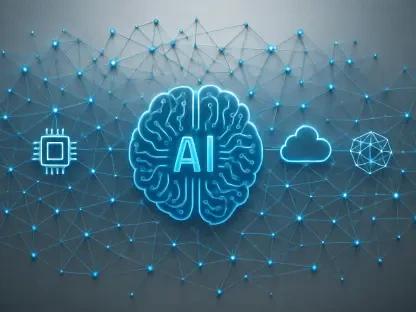The rapid advancement of artificial intelligence (AI) and cloud computing has revolutionized numerous industries, but it has also introduced new and sophisticated cyber threats. The traditional security strategies that enterprises have relied on are no longer sufficient to combat these evolving dangers. Businesses and cybersecurity architects must adjust their tactics to effectively protect their digital assets in this new era.
The Expanding Cloud Threat Landscape
Increased Vulnerabilities and Misconfigurations
One significant concern is the expanding attack surface due to the widespread adoption of cloud computing. Public and shared cloud environments often lead to critical vulnerabilities. For instance, misconfigurations remain a major issue, as evidenced by the 2019 Capital One breach, which exposed 106 million customer records due to a firewall misconfiguration. Misconfigurations are the primary attack vector, with 80% of data breaches occurring in cloud environments.
The National Security Agency (NSA) has identified misconfigurations as a prevalent issue in cloud environments. These misconfigurations can result from inadequate security protocols and insufficient understanding of the complex, dynamic nature of cloud infrastructure. Often, the shared responsibility between cloud service providers and their clients creates gaps in security, leading to weaknesses that cyber attackers can easily exploit. To mitigate risks, organizations must implement rigorous configuration management procedures, consistent monitoring, and continuous adjustments to their security settings.
Impact of Public Clouds on Security
As organizations continue to migrate to public clouds for scalability and efficiency, they must also grapple with the inherent security risks. Shared infrastructure and third-party integrations increase the likelihood of exposure. Balancing the benefits of public clouds with stringent security controls is paramount to reducing these risks.
Public cloud environments necessitate robust security frameworks to prevent data breaches and unauthorized access. The multi-tenancy nature of public clouds means that data from different organizations is stored on the same infrastructure, increasing the risks of cross-contamination and data leakage. Security measures such as encryption, access controls, and continuous monitoring of network traffic are essential in safeguarding sensitive information. Businesses must also demand transparency and stringent controls from cloud service providers to ensure compliance and security of their digital assets.
AI-Induced Threats and Vulnerabilities
AI in Attack Strategies
AI doesn’t just play a role in defense; attackers are also utilizing AI to enhance their capabilities. AI-driven tools enable the automation of scanning and exploiting vulnerabilities, making cyberattacks more efficient and harder to detect. The CrowdStrike Global Threat Report 2024 indicates a sharp increase in cloud-conscious attacks, with AI playing a key role.
These AI-aided attacks include sophisticated phishing schemes, automated penetration testing, and anomaly detection bypass techniques. Cybercriminals leverage machine learning algorithms to analyze vast datasets and identify new vulnerabilities faster than manual methods. This automation reduces the time and expertise required to launch effective attacks, allowing even less-skilled attackers to pose significant threats. As adversaries become more adept at using AI, organizations must adopt equally advanced defenses, including AI-powered threat detection and response systems, to maintain resilience against these evolving threats.
AI-Created Coding Vulnerabilities
AI-powered coding assistants, though they aim to improve developer efficiency, often generate insecure code. A 2023 Snyk report found that a majority of AI-generated coding suggestions had security flaws, including weak encryption and exploitable vulnerabilities. This adds another layer of risk to the software supply chain, necessitating rigorous review and vetting processes.
The use of AI in software development introduces risks that can proliferate throughout the software supply chain if not adequately managed. Developers relying on AI-generated code snippets may inadvertently integrate security flaws into critical applications. Vulnerable code can serve as an entry point for attackers to compromise entire systems. Implementing continuous security assessments, code reviews, and adopting best practices in software development lifecycle management are crucial steps for ensuring that AI-generated code does not undermine overall security posture.
Addressing Public AI Models and Data Security
Risks of Public AI Models
Public AI models, such as ChatGPT, pose significant security risks due to the vast datasets they train on. These models can inadvertently leak sensitive data and are susceptible to adversarial attacks. In March 2023, for example, ChatGPT experienced a significant data leak due to a vulnerability in the Redis library, highlighting the potential dangers.
The open and extensive nature of training data for public AI models exposes them to risks such as data poisoning, model inversion, and membership inference attacks. These threats can compromise the integrity and confidentiality of the models, leading to unintended data leaks and exploitation of model weaknesses. Adversaries can manipulate training data to alter model behavior subtly, creating backdoors that can be exploited later. Ensuring the security and integrity of training data and model outputs is vital to mitigating such AI-specific vulnerabilities.
Protecting Sensitive Data in AI Applications
Organizations using public AI models must implement robust data governance and access controls to mitigate the risks. This includes securing proprietary data and ensuring compliance with relevant data protection regulations. Federated AI and edge AI processing can also help minimize exposure by keeping sensitive data decentralized.
Implementing advanced privacy-preserving techniques such as differential privacy and homomorphic encryption can safeguard sensitive information in public AI model deployments. Federated learning allows training AI models across decentralized devices holding local data samples without exchanging these samples. This methodology reduces the risk of data breaches by ensuring that sensitive data remains on local devices rather than being transferred to a central server. Moreover, establishing clear policies and procedures for data handling, access control, and regular audits can fortify the security framework around AI applications.
Revisiting Legacy Security Models
Limitations of Traditional Zero-Trust Architecture
The integration of AI and cloud computing complicates existing security frameworks, such as zero-trust architecture (ZTA). Designed for more static enterprise networks, traditional ZTA struggles with the dynamic nature of cloud workloads and distributed access requests. This necessitates an evolution toward more adaptive security models.
Zero-trust principles emphasize verifying every request as if it originates from an open network, but static, rule-based approaches are insufficient for the dynamic, distributed environments of modern cloud infrastructures. Traditional ZTA lacks the capability to adapt to rapid changes in workloads, user locations, and access patterns typical in cloud-native and AI-driven environments. Enhancing ZTA with real-time, context-aware policies that leverage AI-based anomaly detection and behavioral analytics can better address these modern complexities and provide more effective security.
Real-Time Threat Identification and Response
To counter AI-automated and disguised attacks, organizations need to employ adaptive, behavior-based security measures. Real-time visibility and monitoring of the security landscape are critical for identifying and responding to threats effectively. Leveraging AI for dynamic threat detection can enhance an organization’s ability to respond to attacks in real time.
Behavior-based security systems use machine learning to profile typical user and system behavior, creating baselines that significantly improve threat detection accuracy. These systems can promptly identify anomalies indicative of malicious activities, such as unusual access patterns or data exfiltration attempts, by continuously learning and adapting. Combining AI-driven detection with automated response mechanisms enables swift actions to isolate and mitigate threats, minimizing potential damage. Investing in such adaptive, intelligent security technologies is essential in keeping pace with the growing sophistication of AI-enabled cyber threats.
Strengthening the Software Supply Chain
Ensuring Secure Software Dependencies
Securing the software supply chain is crucial in an AI and cloud-driven landscape. Enterprises must rigorously vet third-party dependencies and AI-generated code for vulnerabilities to prevent potential exploits from being embedded in their software. Automated security scanning tools can aid in identifying and mitigating these risks.
Dependency management requires vigilance in monitoring open-source libraries and third-party components, as vulnerabilities within these assets can expose the entire system. Regularly updated vulnerability databases, security advisories, and automated dependency scanning tools should be integrated into continuous integration and deployment (CI/CD) pipelines. This proactive approach enables timely detection and remediation of security flaws. Additionally, implementing strict policies for dependency usage and requiring code audits can ensure that all external components meet stringent security standards.
Preparing for Future Technologies
Looking forward, advances such as quantum computing pose new challenges. Quantum-resistant cryptographic methods should be explored to protect against future threats that could render current encryption obsolete. By staying ahead of technological advancements, businesses can better safeguard their digital assets.
Quantum computing promises to revolutionize various fields, but it also threatens to break conventional encryption algorithms upon which current internet security relies. As quantum computers become more feasible, transitioning to quantum-resistant cryptography is imperative. Researchers are developing new algorithms such as lattice-based, hash-based, and multivariate polynomial cryptography to withstand quantum attacks. Organizations must stay informed about these advancements and plan for gradual implementation to future-proof their security systems effectively.
By preparing for the inevitable evolution of technology, cybersecurity efforts can remain robust against emerging threats, ensuring the ongoing protection of sensitive data and critical infrastructure.
Conclusion
The swift progress of artificial intelligence (AI) and cloud computing has transformed various industries dramatically, offering unprecedented opportunities and improvements in efficiency. However, these technological advancements have also led to the emergence of complex and sophisticated cyber threats. Traditional security measures, once considered adequate, are now insufficient to counter the ever-evolving landscape of cyber risks. As a result, organizations and cybersecurity professionals must rethink and update their defensive strategies to safeguard their digital assets effectively in this new technological era. It has become imperative for businesses to stay ahead of potential threats by adopting advanced security solutions, investing in continuous monitoring, and training their workforce in cybersecurity best practices. By doing so, they can ensure they are well-equipped to navigate the challenges posed by today’s digital environment while capitalizing on the benefits that AI and cloud computing bring to the table.









